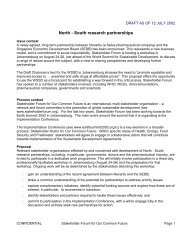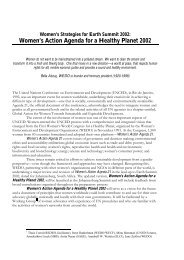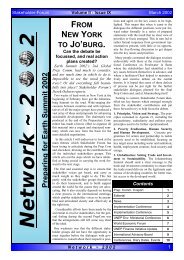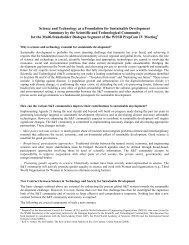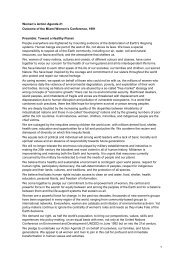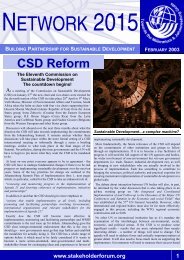How to use the Public Transport Gender Audit Checklist
How to use the Public Transport Gender Audit Checklist
How to use the Public Transport Gender Audit Checklist
You also want an ePaper? Increase the reach of your titles
YUMPU automatically turns print PDFs into web optimized ePapers that Google loves.
Families headed by a lone mo<strong>the</strong>r in <strong>the</strong> US have considerably higher poverty rates <strong>the</strong>n any o<strong>the</strong>rtype of ho<strong>use</strong>holds. In 1994, 44% of single women ho<strong>use</strong>holds were living below <strong>the</strong> poverty level.And <strong>the</strong>se families constituted a substantial portion of all poor families in <strong>the</strong> US almost 60% in 1994. 8In addition, beca<strong>use</strong> of changes in <strong>the</strong> age-structure <strong>the</strong>re are now more older people in need ofhome-based care. The carers of <strong>the</strong>se sick and elderly adults are nearly always unpaid, and are almostexclusively women.Considerations such as <strong>the</strong>se mean that part-time work opportunities are important <strong>to</strong> women, particularlylocal opportunities. This fur<strong>the</strong>r means that women tend <strong>to</strong> be concentrated in<strong>to</strong> lower-level jobswhere <strong>the</strong>re is a high proportion of part-time staff; and <strong>the</strong>y are more likely <strong>to</strong> be precluded fromhigher-level jobs e.g. managerial and professional work which are predominantly full-time. 9The persistent economic inferiority of womenEven after many years of Equal Pay legislation, women’s pay lags behind that of men. In 1998 in <strong>the</strong>UK, <strong>the</strong> average male full-time hourly rate was £9.22 (part-time £6.71), while for women, <strong>the</strong> full-timerate was £7.48 (part-time £5.68) 10 . The EOC notes that throughout <strong>the</strong>ir working lives women generallyearn less than men, regardless of whe<strong>the</strong>r <strong>the</strong>y are managers or in lower-level jobs. This is beca<strong>use</strong>of women’s weaker attachment <strong>to</strong> <strong>the</strong> labour market, which is, in turn, linked <strong>to</strong> <strong>the</strong>ir cus<strong>to</strong>marycaring roles within families. It is also linked <strong>to</strong> <strong>the</strong> different jobs carried out by women and men whichhas its roots in <strong>the</strong> traditional gender split in subject choice at school. 11In Sweden where sexual equality is considered <strong>to</strong> be one of <strong>the</strong> highest in <strong>the</strong> world, equality betweenmen and women is still not evident in employment status and wages. In 1994 women working full timewere earning 78% of men's salary within <strong>the</strong> private sec<strong>to</strong>r, and 83% within <strong>the</strong> public sec<strong>to</strong>r. Typicallyfemale employment, such as teaching, nursing and service jobs command lower levels of pay thantypical male employment. Even women with higher education do not earn as much as <strong>the</strong>ir male counterparts.Within <strong>the</strong> public sec<strong>to</strong>r in Sweden, college educated women earn between 85-89% of men'ssalary.In many parts of <strong>the</strong> developed world <strong>the</strong> largest increase in women's employment since 1970 hasbeen in part time work. 12 Women’s earnings as part-time workers tend <strong>to</strong> be low, not only beca<strong>use</strong> of<strong>the</strong> pro-rata reduction, but also beca<strong>use</strong> part-time workers generally are in a vulnerable position in <strong>the</strong>labour market. Available figures may represent an underestimate of <strong>the</strong> scale of <strong>the</strong> problem, since<strong>the</strong>y are based on official statistics, while much of women’s part-time labour is casual and <strong>the</strong>reforenot recorded.In addition, <strong>the</strong> jobs that men do tend <strong>to</strong> be <strong>the</strong> more highly paid ones and men are more often employedat higher grades. Two thirds of managers and administra<strong>to</strong>rs and three out of five professionalsin <strong>the</strong> UK are men. 13 Fur<strong>the</strong>rmore, women are concentrated in <strong>the</strong> service sec<strong>to</strong>r of <strong>the</strong> economywhere wages have traditionally been lower— In <strong>the</strong> UK in 1997 around 86 % of women worked in <strong>the</strong>service industries compared with 59 % of men. 14In <strong>the</strong> US <strong>the</strong> <strong>to</strong>tal number of service sec<strong>to</strong>r jobs grew <strong>to</strong> over 70% from 1970-90. This resulted inaround 85 million service sec<strong>to</strong>r jobs or 72% of <strong>to</strong>tal employment. In 1990 women held 52% of <strong>the</strong>sejobs but 68% of <strong>the</strong>se were part time. 15"Moonlighting" or multiple-job holding by women has increased in <strong>the</strong> US in line with <strong>the</strong> increase inho<strong>use</strong>holds headed by females. According <strong>to</strong> Sandra Rosenbloom:"These remarkable changes in <strong>the</strong> economic patterns of <strong>the</strong> country affect not only where womenwork but when; most of <strong>the</strong> changes involve a variety of work schedules. Census data show that almost40% of all women workers do not have a day shift job 23% of all fulltime working mo<strong>the</strong>rs andalmost 69% of those working part-time not only don't work <strong>the</strong> classic nine till five day, <strong>the</strong>y don't evenwork most of <strong>the</strong>ir hours during that traditional period". 16This is not <strong>to</strong> deny that <strong>the</strong>re are indications of an increasing polarisation among women’s incomes,which needs <strong>to</strong> be seen in <strong>the</strong> context of widening social and economic inequalities over <strong>the</strong> past twodecades. 17 Despite this, however, <strong>the</strong> differences between men and women remain more marked.Why are women so badly paid and why do <strong>the</strong>y work part-time when <strong>the</strong> financial rewards are so low?The economic inferiority of women has much <strong>to</strong> do with women’s labour being less highly valued thanmen’s. 18 Additionally, women have fewer employment options than men: domestic and childcare re-4




